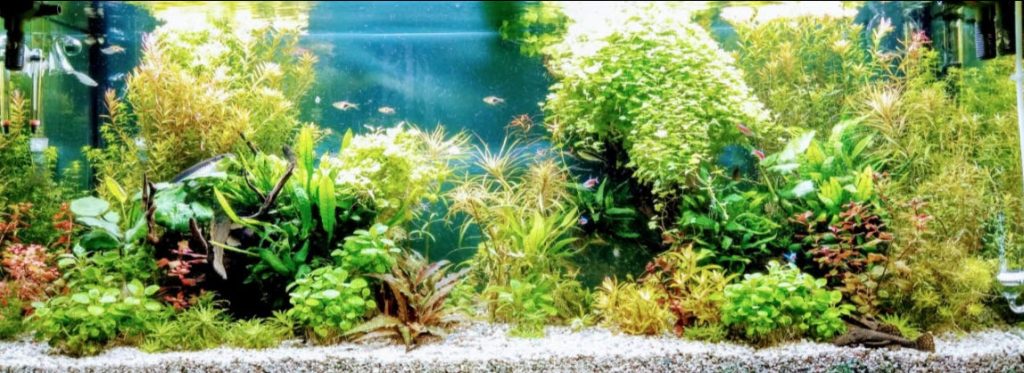
Plant Substrates in a Nutshell
Most aquarium plants grow in pretty much any aquarium substrate. Let me emphasize that point;
.
Most aquarium plants grow in pretty much any aquarium substrate
.
Mother Nature is just very forgiving. This makes things very confusing for the beginner. They watch one YouTube video where the video maker uses one way of setting up a planted tank and swears it is the ONLY way one can do it and trashes all other methods. Then they watch another video where the video maker swears his way, which is diametrically opposed to what the first video maker is doing, is the ONLY way to have a good planted tank and trashes all the other methods. So things get very confusing very fast.
An illustration is in order. One hobbyist planted and overstocked an aquarium with Lake Malawi cichlids. This low tech tank was incredible after a year an a half:
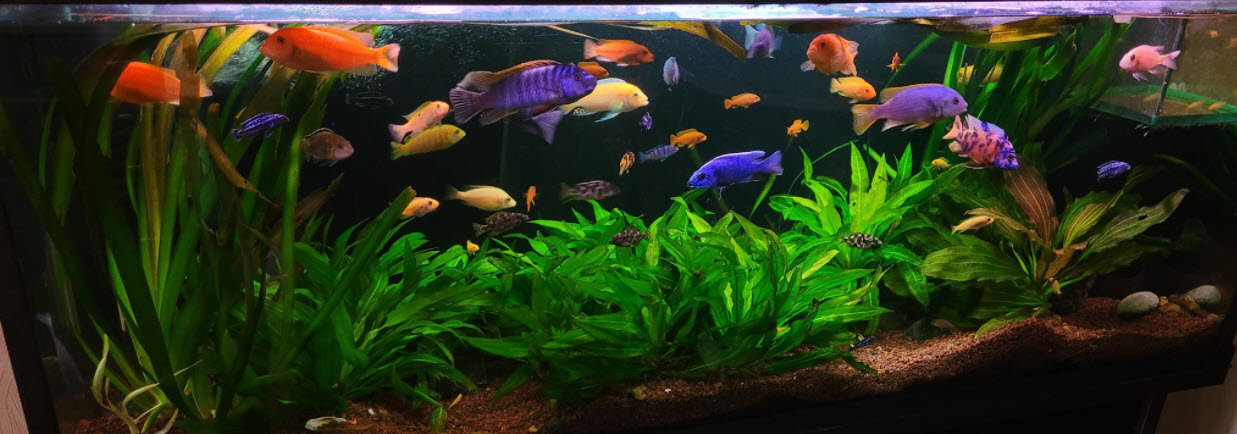
This aquarium violates EVERY “rule” in the book! The substrate is just “crushed lava rock” (I’m guessing it was CaribSea Eco-Planted basaltic gravel). There is some vallisneria and a lot of Amazon swords (Echinodorus amazonicus and E. bleheri). This low tech tank is a year and a half old with a pH of 7.0. The fish have been in it the whole time and are decidedly overstocked, which I would have said was completely and totally impossible. Gorgeous and amazing! So much for my pale attempts at a planted tank with Africans.
This article is one of my very long and boring dissertations. Read on only if you are a real nerd, like the author.
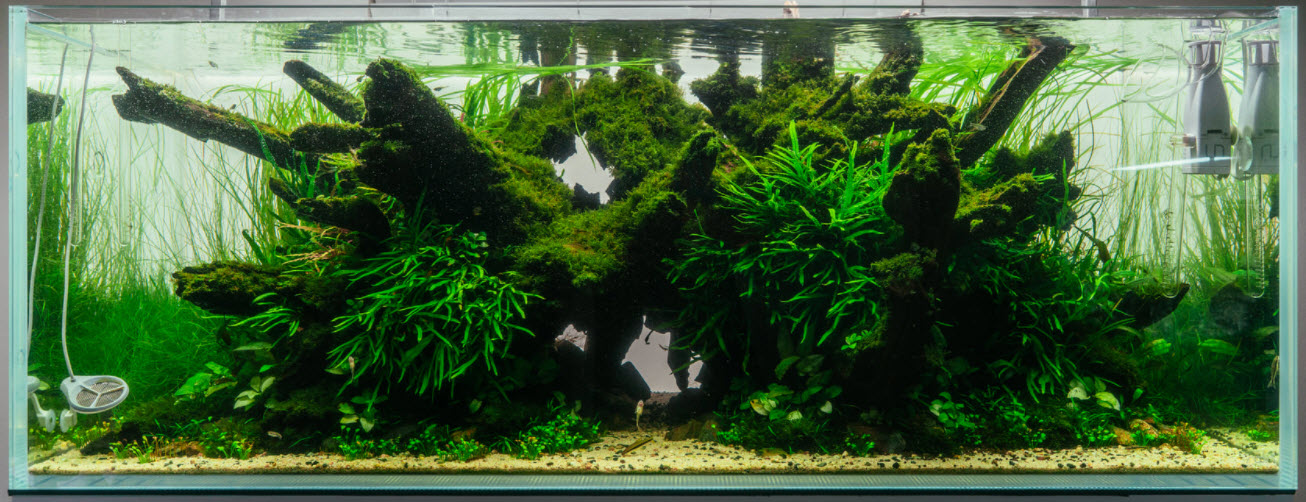
Summary
There are five basic types of substrates used in planted tanks.
- Just good old sand or gravel. Can be made to work well in all types of planted aquariums.
- A cellulose rich “soil” substrate under a cap of sand or gravel. Generally used in low tech planted aquariums but, in truth, works well in high tech as well.
- Expensive commercial “aquarium soils” (small, sharp, hard, red or black gravels) which are used in high tech planted aquarium tanks. These are all snake oil products not worth the expense.
- Very expensive porous, lightweight “volcanic ash soil” products (range from powders to quarter inch diameter balls) which typically slowly dissolve into a fine powder in an aquarium over a span of a year or two. These products are not worth the expense but if one is intent on using them they are best used as a fertilizer. Mix 10% to 20% of these substrates into any planted substrate.
- Calcined clay products such as Kitty Litter or Oil absorbents. Very inexpensive substrates that grow plants very well. Don’t work well in under-gravel filters.
I have found very little difference in the substrate performance. I have found that, in general, the deeper the substrate, the better the plants grow.
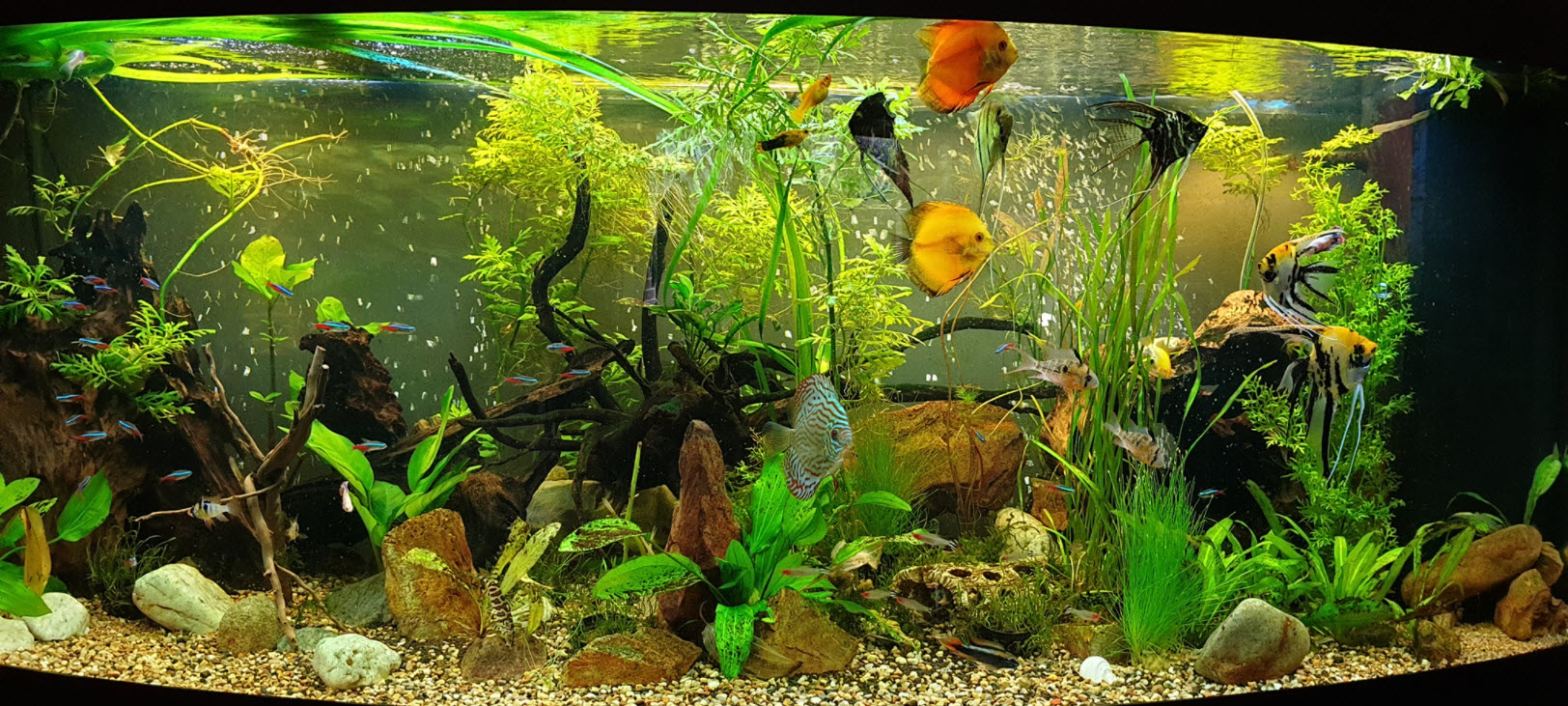
Substrate by Type of Planted Aquarium
There are three distinct types of planted aquariums:
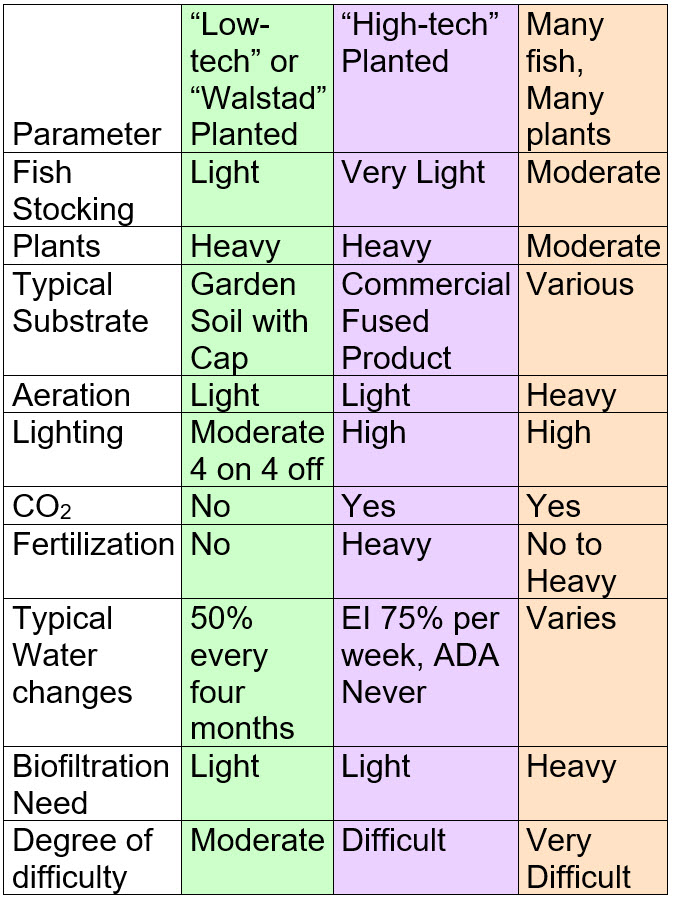
There are of course a million variations on these themes but the type of aquarium one is setting up is sometimes important to what the substrate can be. We look at that in boring depth below.
Low Tech Planted Tanks
In general, in low tech planted tanks (no CO2, low light, low fertilization) the finer the substrate (down to sand, not clay) the better the plant growth CAN be. And one typically needs to avoid high nitrogen organics in the substrate. But other than that, most aquarium plants are very forgiving. And even then some very successful aquarists do things like adding large amounts of nitrogenous organic matter to the substrate and their plants do just fine. A lot depends on what one wants in a low tech planted aquarium.
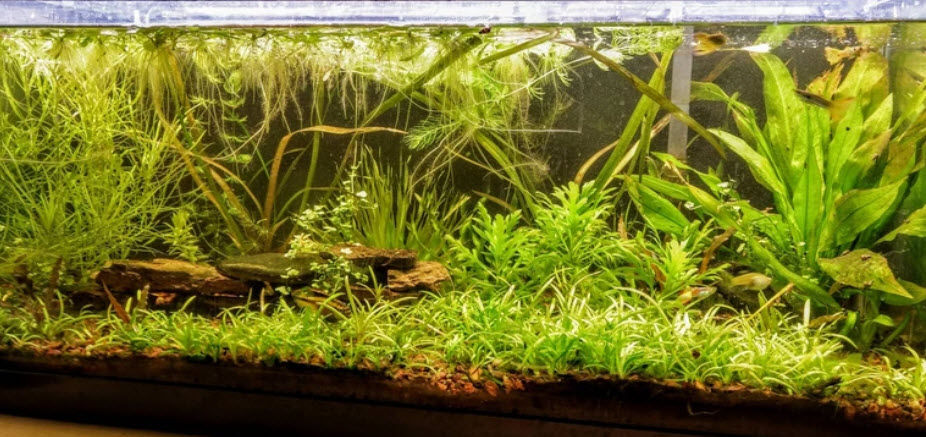
Substrate for Low Tech Walstad Aquarium
Diana Walstad’s low tech planted aquariums have very cellulose rich but low nitrogen (0.10%) “soils” in them. She uses one inch of cellulose rich potting soil covered with half an inch of gravel. More about what she uses in this link:
15.7. Walstad Aquarium
Now any substrate CAN be used for a “low tech” planted aquarium. One CAN use sand, gravel or commercial soils. Some hobbyists even use under gravel filters in low tech planted tanks. With the right plant selection ANY of these variations can be made to work. Mother Nature is just VERY flexible. We have a low tech scheme that uses wood pellets as the substrate described in this section:
15.10. Hybrid Planted Aquarium
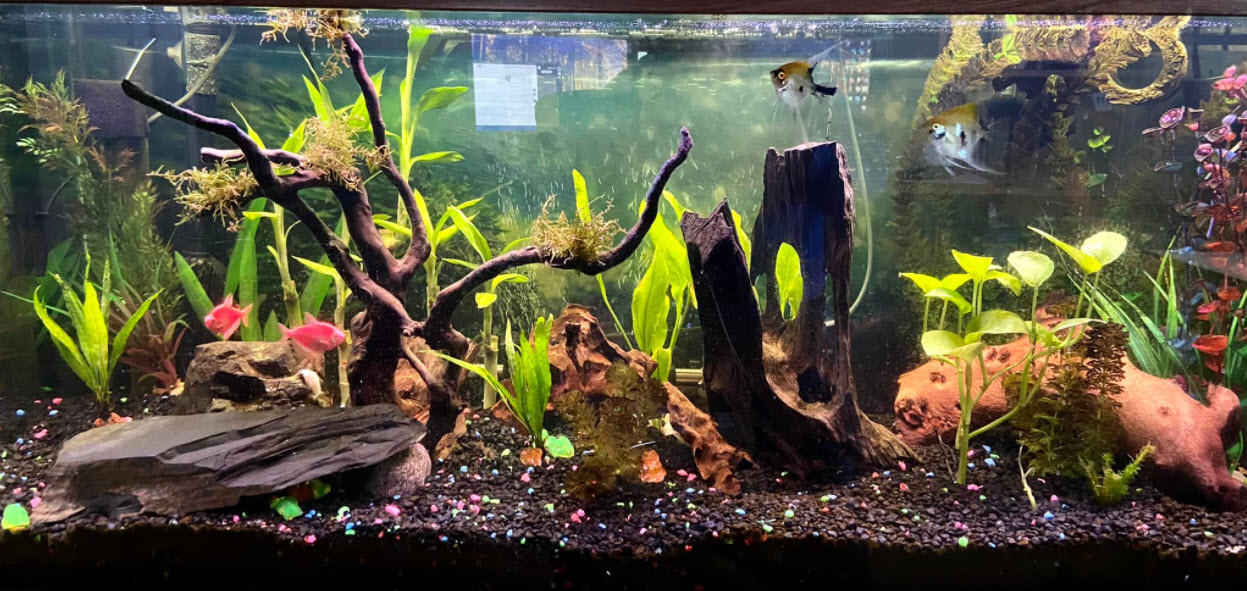
Substrate for Many Fish, Many Plants Aquariums
There is a YouTube video maker, Father Fish, who used an organic deep sand bed in what appear to be about fifty heavily stocked fish aquariums in his store. Father Fish adds a whole bunch of very nutrient rich “stuff” to very organic potting soil (looks like African violet mix to me). He uses one inch of this soil mix for the first inch in his deep sand bed planted low tech aquariums. He adds worm castings, peat moss, Black Kow compost, blood meal, organic snail food, iron supplement, Osmocote, lime, and Epsom salts. He then adds three to four inches of sand over that mix.
Father Fish has used this method for his many low tech planted aquariums with a large quantities of fish in them. Note Father Fish uses significant aeration and uses no CO2 injection. Note the thick second sand layer is important. Father Fish’s compatriot, E.J. used a one inch cap. She got a cesspool. Here is one of Father Fish’s deep sand bed tanks:
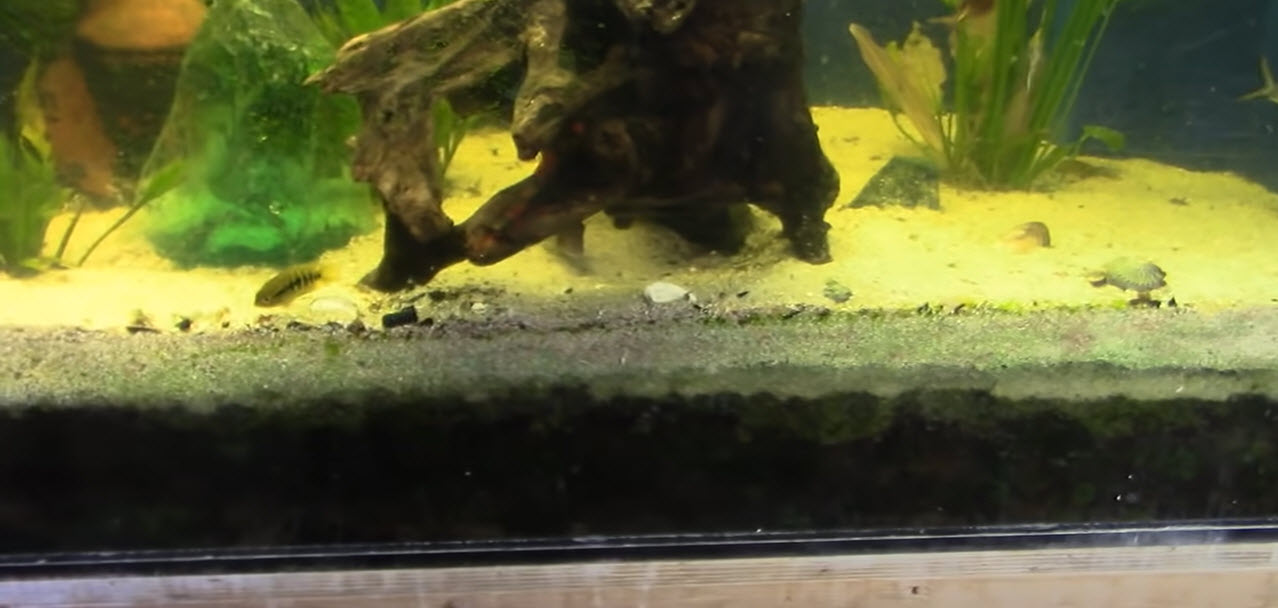
MASS Aquariums had an aquarium with lots of plants and lot of fish. They used a one-inch layer of organic soil (looked like a commercial potting soil) covered with a one-inch layer of black gravel. They had carbon dioxide pressurized injection, significant aeration, an intense LED lighting system and heavy fertilization.
Again, Mother Nature is VERY flexible. If one has an idea for a substrate in a planted aquarium go ahead and try it.
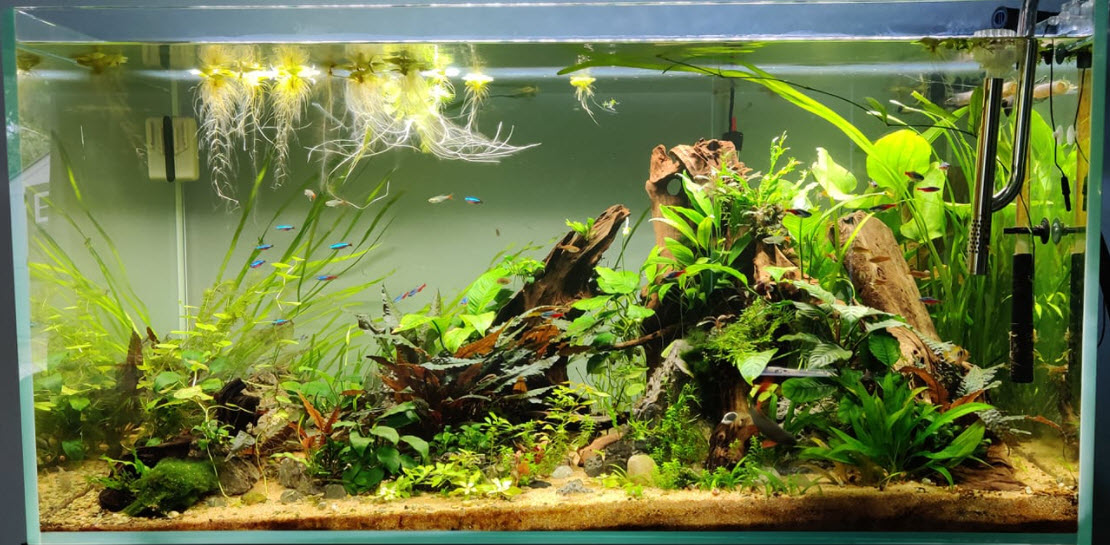
Substrate for High Tech Aquariums
Most “high tech” (CO2 injected, high fertilization, high light) planted aquarium hobbyists use commercial aquarium “soils”. There are two types of commercial “soils”. One is a hard product that doesn’t decompose with time. This is typified by the red laterite like red Fluval Stratum. The various hard apparently calcined clay (or possibly ground weathered rock) “laterite” gravels SOMETIMES provide iron over a period of time.
The other type of product decomposes slowly with time. This appears to be a “baked” soil product. The various “baked” spherical pellets and sand to powder “volcanic ash” products release all the various nutrients slowly over the span of about one year. They should be viewed as extremely expensive fertilizers.
In truth any substrate will work well in a “high tech” (CO2 injected, high fertilization, high light) planted aquarium. The substrate just isn’t anywhere near as important as all the marketing hype suggests it is.

Commercial Planted Aquarium Substrates
There are two types of commercial planted aquarium substrates, fused and baked. It isn’t easy to tell which is which. If the product is hard, somewhat heavy and doesn’t have a reputation of decomposing in the aquariums, it is “calcined” clay, or basically ground up fused clay. This product could also be ground up weathered lava rock. If the expensive commercial substrate is softer, lighter in weight, and has a reputation of decomposing in the aquarium, it is probably a “baked” product.
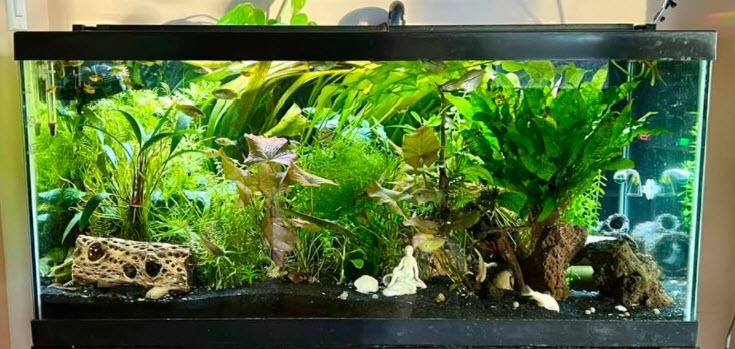
Expensive Calcined Substrates (sometimes called “inactive” substrates)
Expensive substrates such as Fluval Stratum, Seachem Fluorite and some forms of CaribSea Eco-Complete are NOT necessary to have a beautiful planted aquarium. Indeed, these substrates are identical to aquarium gravel and Kitty Litter (and POSSIBLY iron root tabs) as far as how much they benefit plants in the aquarium.
These products absorb water but they are very hard. This means they are either crushed weathered lava rock or a calcined volcanic clay. If they are crushed weathered lava which has been ground up and sorted they are simply inert, just like aquarium gravel. Crushed weathered lava rock cannot provide iron. The iron that creates the red color is tied up very firmly in ferric hydroxides and oxides. This crushed rock is the same as any other crushed rock, such as crushed slate.
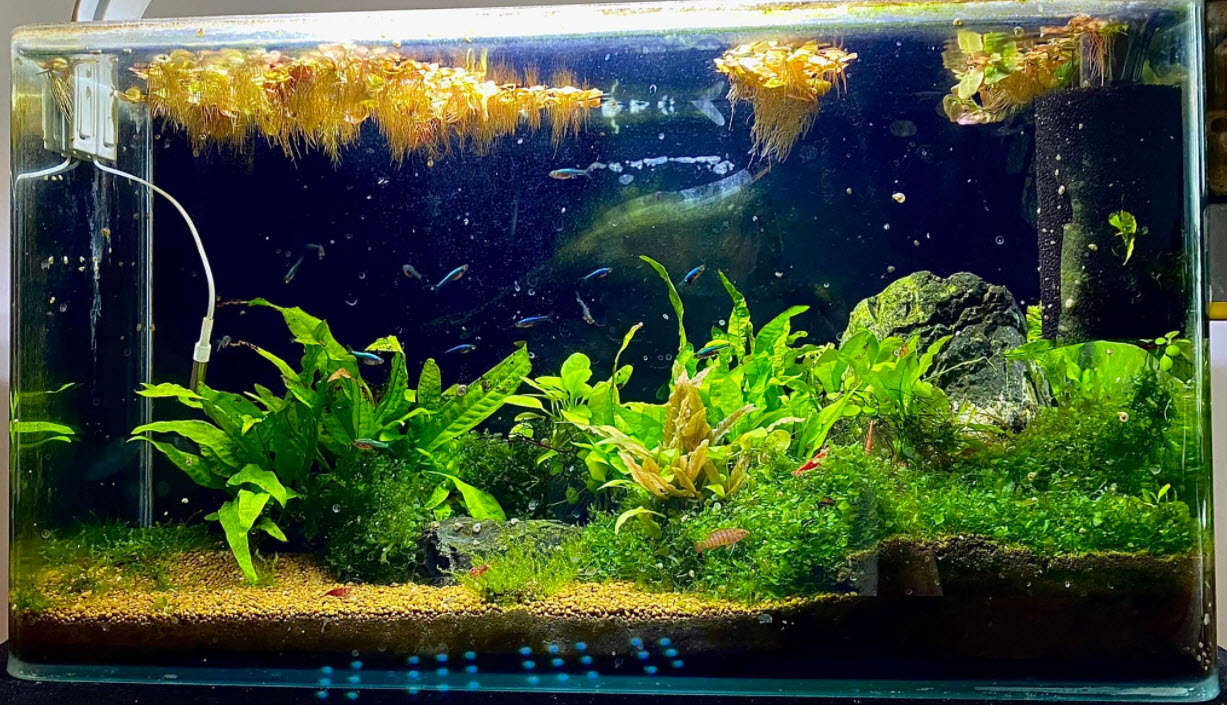
These products may also be simply iron rich clay soils (actually these soils are called “laterite”) which are “calcined” in slabs in an oven and then crushed and sorted. Calcination occurs around 14000 F. There are varying amounts of both iron oxides and carbon compounds in these soils.
When the soils are calcined the carbon may reduce some of the ferric iron oxides to ferrous iron compounds in microscopically small particles scattered through the product pores. So these soils MAY POSSIBLY provide iron to the plants. Note that when clay is fused it loses all its “good” cation exchange properties and becomes inert rock, just like slate. Indeed, slate is just clay which has been pressurized and heated in the earth.
Normally one shoots for 0.5 ppm ferrous iron in the planted aquarium water. Diana Walstad used some red laterite commercial “soils” in one of her planted tanks and the plants died. When she measured the iron it was 60 parts per million. Iron at this level can kill plants. So using these red substrates entails some risk.
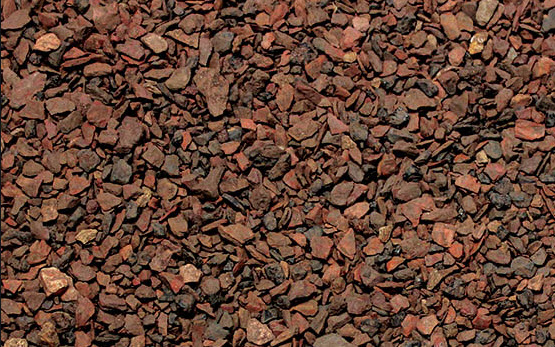
The most commonly used calcined iron rich clay soil or ground up weathered lava rock are the various Seachem Fluorite and Fluval Stratum products. Some forms of CaribSea Eco-Complete and FloraMax also are simply ground up calcined iron rich clay soil or ground up weathered lava rock. A typical piece of marketing hype for these products is the following:
“CaribSea FloraMax Planted Aquarium Substrate contains iron, magnesium, calcium and other elements to promote plant growth.”
The marketing hype continues with:
“CaribSea FloraMax Planted Aquarium Substrate eliminates the need for laterite”
Now this marketing hype MAY POSSIBLY be true. But what most hobbyists miss that iron can easily be provide in the form of root tabs at a much lower cost with much greater assurance iron is indeed there.
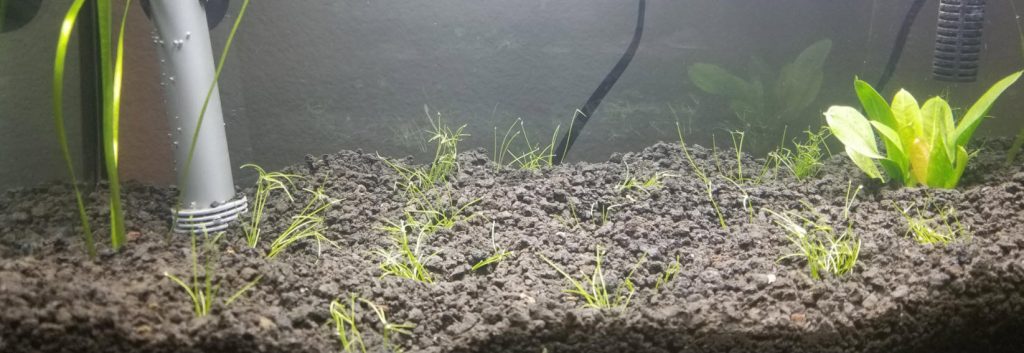
The marketing hype continues with:
“The macro-porosity of CaribSea FloraMax Planted Aquarium Substrate helps to rapidly convert fish waste into natural food for plants and maintain an ideal biological balance.”
The “fish waste” utilized by plants is largely the ammonia given off by the fish. So there is no need for any conversion by the substrate. And the whole concept that “macro-porosity” is advantageous to beneficial bacteria is one big scam. It doesn’t happen as the pores are far too small for beneficial bacteria to grow in the pores and the pores have no flow through them.
.
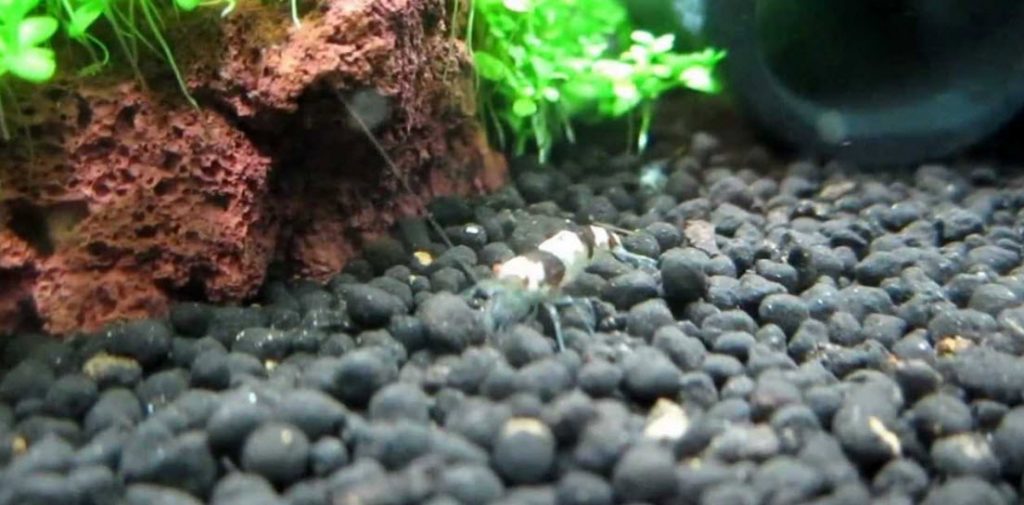
Baked Substrates (sometimes called “active” substrates)
Fluval Stratum, Ultum Nature Controsoil and ADA Aquasoil Amazonia are very expensive products which appear to be “baked” soils. They are typically small irregular spheres about 3/16ths inch in size (7 mm). They are typically “substrate created from the volcanic ash of Mount Aso in Japan”. Some versions of CaribSea Eco-Complete are very similar products.
The size of the particle ranges from spheres down to sand and even powder. These materials are lightweight compared to the commercial soils above and tend to decompose slowly in an aquarium into mud. These products release a complete nutrient spectrum of nitrogen, phosphate, potassium and iron over the first year they are in the aquarium.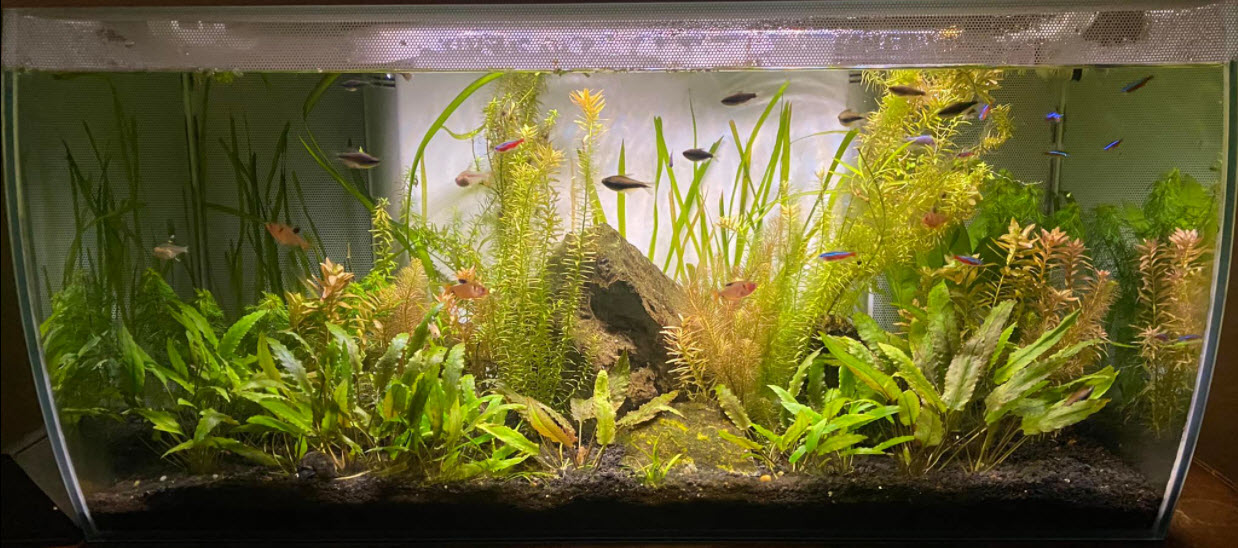
I’m going to speculate that these products are a mix of a volcanic ash soil, black peat, black humic compost (like Black Kow) and a binding agent like Plaster of Paris. These spheres are probably dried and baked in rotating ovens at around 250 degrees F (121 degrees C). This would produce a product which would slowly release nitrogen and phosphate over the span of a year and decompose slowly in an aquarium.
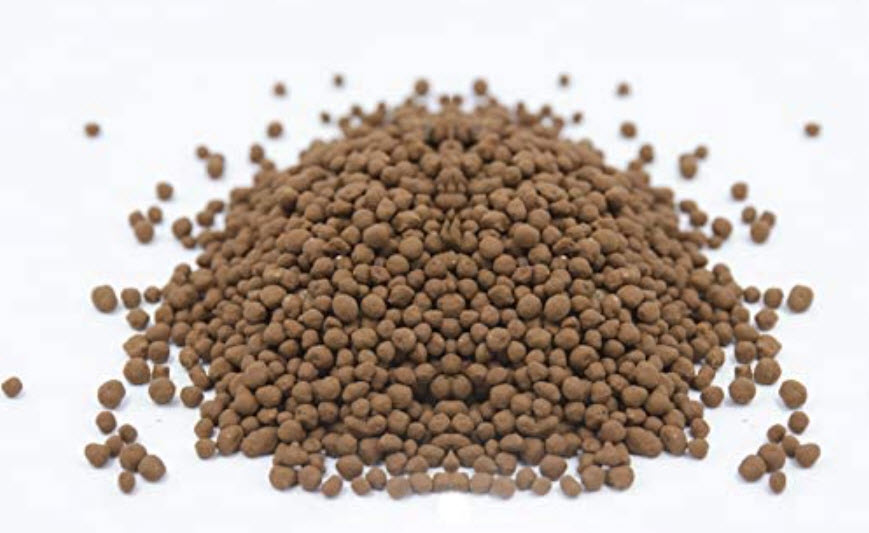
Volcanic ash soils which have weathered for enough time to form hydrated clays can be very rich soils. Hydrated clays have extremely tiny molecular lattices of aluminosilicate plates with water and cations between the plates. Clays like this have what is known as a high “cation exchange capacity” (20 to 100 “CEC”).
But note CEC isn’t very useful in a tank which is fertilized regularly. CEC is like a bank account, a VERY SMALL bank account. It store nutrients until plants need them. This storage is little use in a fertilized aquarium, especially with a constant fertilization program such as the EI methodology. Also, when clay is baked, it fuses and loses its CEC. So I doubt these baked products have a very good CEC.
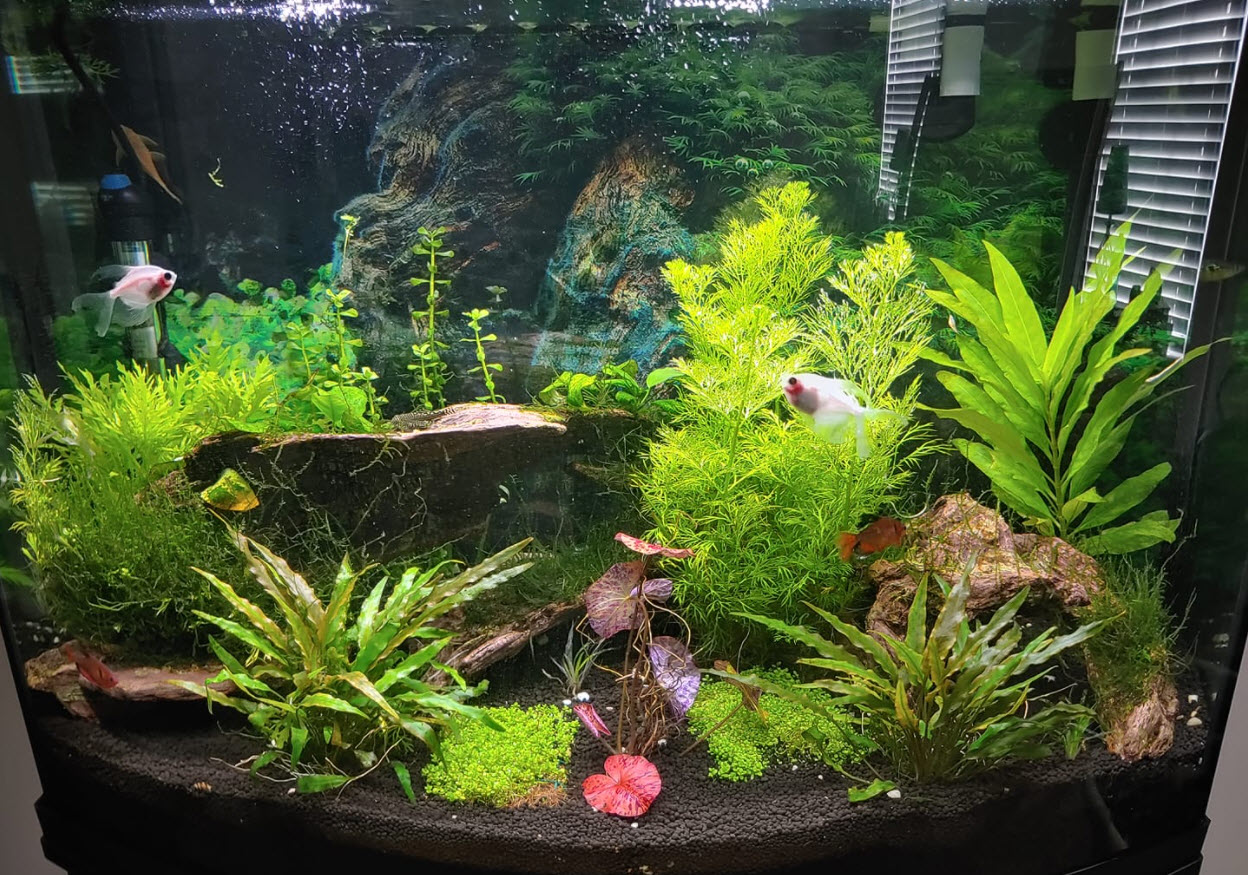
These product are of use if utilized at the 10% to 20% level mixed in with other substrate. For roughly a year they provide nutrients to the plants. After several years they simply become clay mixed in with the substrate. Consider all these products to simply be VERY EXPENSIVE timed release fertilizers. Osmocote in gel tabs or some of the homemade tabs found in the articles below are much cheaper alternatives.
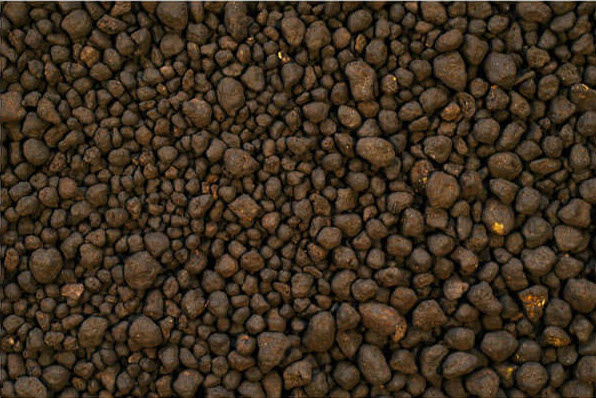
Cheap Calcined Clay Products
Calcined Clay products such as Kitty Litter or Oil Absorbents are very attractive options for a planted aquarium. The biggest reason people might choose to use calcined clay over a traditional planted aquarium substrate is that it’s much cheaper. It is probably the most cost-effective planted aquarium substrate material that there is. Aquarium substrates can be quite expensive, especially if you’re trying to get a deep substrate layer in a very large tank. Calcined clay is a fraction of the price.
Another reason is that some types of calcined clay can provide a more natural look for your aquarium than gravel or sand. This can be especially true if you choose an earth-toned variety of oil absorbent.
Note that calcined clay products have too many fines to work well with an under-gravel filter. This is true even if weed blocking screening or mosquito screening is used.
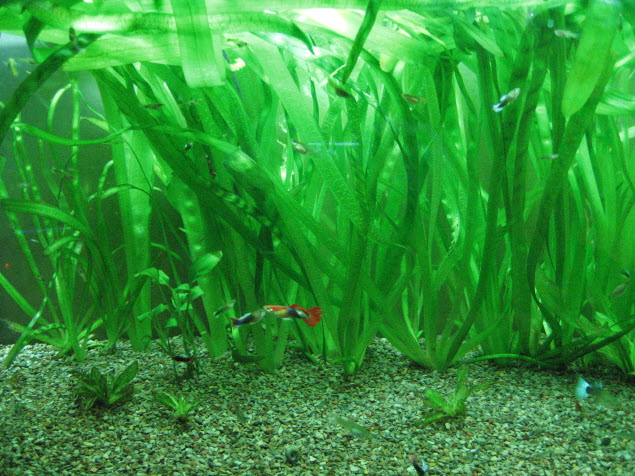
Some cat litters are not calcined (fired) sufficiently to maintain structural integrity (hardness) under water for long durations of time – in other words they turn to mush. Any clumping cat litter will turn to mush. A much better option is to use an oil absorber found in the automotive hardware section of the store. Safe-t-sorb from Tractor Supply is incredibly cheap and very effective as a substrate. It maintains its structure and does not “break down” into mush. I find the mixed light browns of Safe-t-sorb a much more attractive color than the light grey of most Kitty Litters.
Note many will say calcined clay products are good because they have a high Cation Exchange Capacity (CEC) of 27 me/100g. This IS NOT TRUE. The clay which is used to make the calcined clay has a CEC of 27 me/100g. When you heat the clay and calcine it you irreversibly drop the CEC to almost nothing. In any case, in a fertilized aquarium, CEC is meaningless.
Calcined clay products have a lot of dust in them. Much like sand, you will want to keep rinsing calcined clay products until the water runs mostly clear. You may never be able to get rid of all the cloud, but the bulk of it should be removed before adding it to your tank.
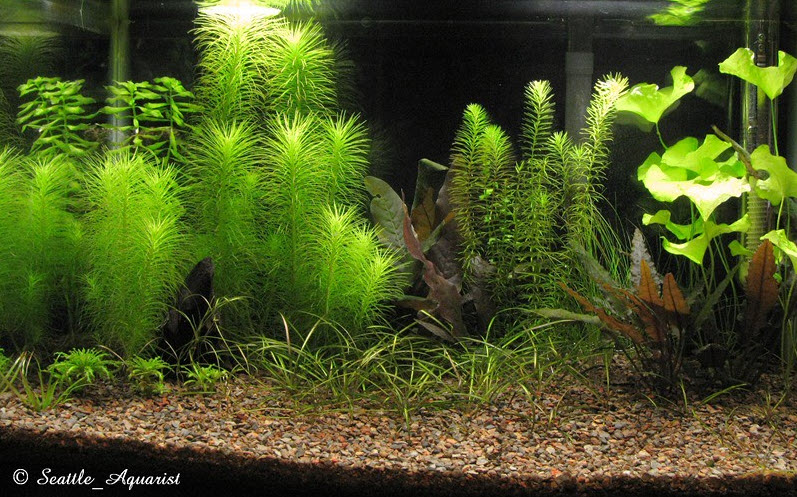
Planted Aquarium Substrate Selection in Depth
The discussion of the particle size of plant substrates depends on how one wants to fertilize the plants. If one adds iron and phosphate to the roots, one needs a small particle sized substrate. If one adds iron and phosphate to the water column (Note I DO NOT recommend doing this!), one can use any size substrate for plants.
The most important variable when selecting any substrate when using plant tabs is the particle size of the substrate. The smaller the particle size the less the water movement in and out of the substrate. The less the water movement the more the chemistry of the substrate gets isolated from the chemistry of the water column. This isolation is important with plant tabs. In general plants fertilized with plant tabs or baked commercial soils do best with substrates less than 1 mm in diameter.
The sizing of the substrate is as follows:
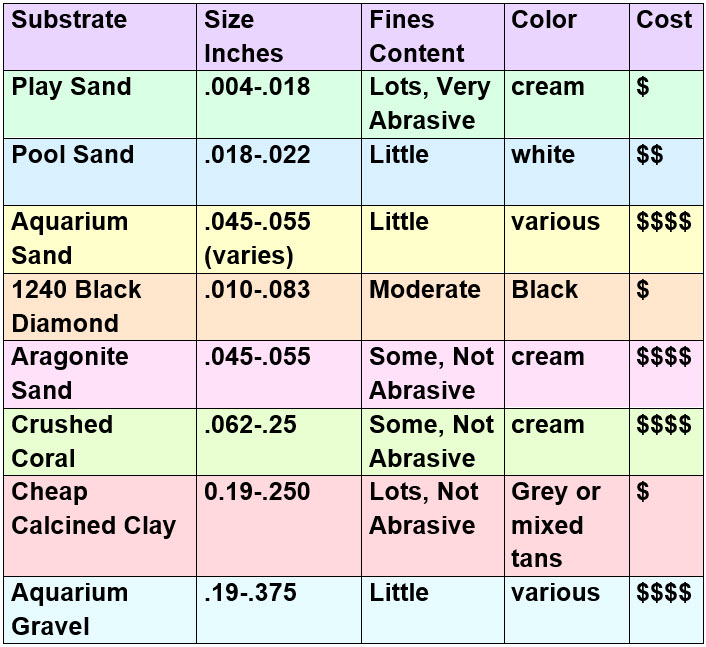
The small the diameter of the particle the better the substrate for plants. But note that fine substrates can create real problems with pumps. And cheap fine sand is always white. White sand shows every piece of poop floating on it in stark contrast. It is not attractive, at least not for us.
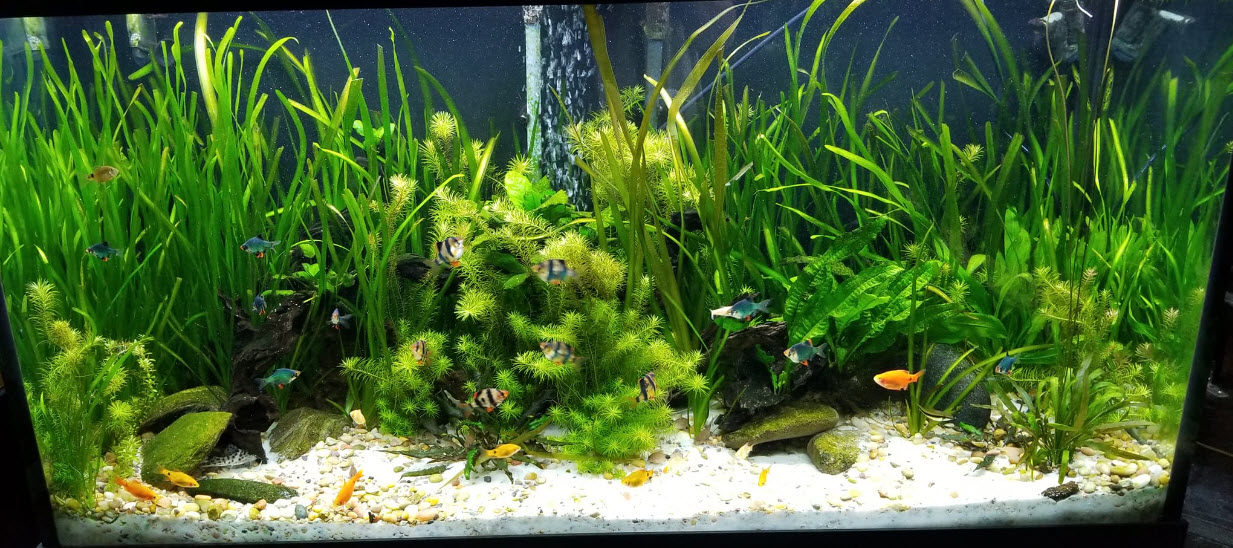
We much prefer the coarse aquarium sand sold in all fish stores (natural medium brown mixed with dark brown) mixed with 1240 Black Diamond Medium Blasting Abrasives from Tractor Supply. Mixing three colors of sand gives the most natural bottom look that doesn’t show if the organic matter comes to the surface during re-arranging.
Note several years ago, at a builder supply house, I found some cheap fifty pound bags of something called “decking sand” which was very coarse sand with little in the way of fines. The color was cream through dark brown and it works very well in some “natural” planted tanks I have. When you find something like this I recommend buying a LOT of it.
Also note that this “isolation” becomes much more important as the pH of the water rises. At 7 pH two mm substrate will be fine, at 8 pH one will typically not get optimum growth of rooted plants unless the substrate is below 1 mm.
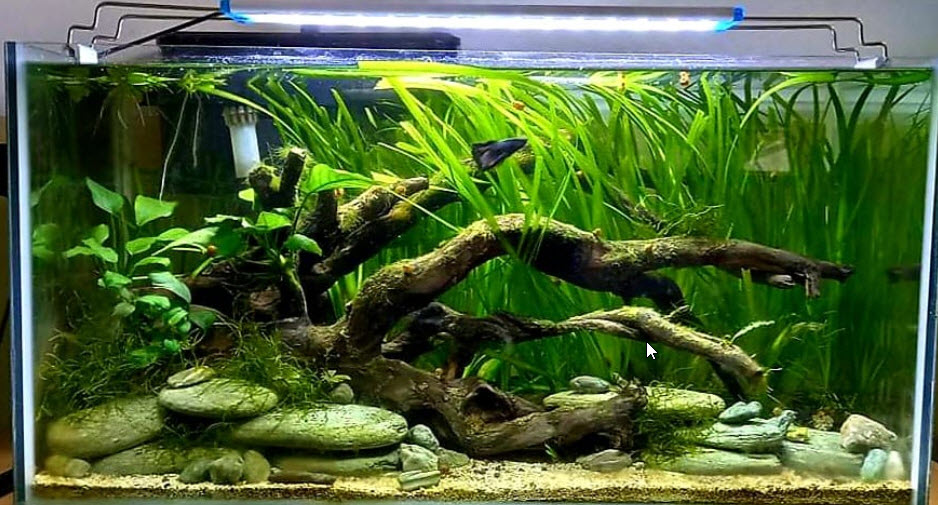
Pots as Substrate
And finally there is one approach which is often overlooked. This is to simply put the plants into clay pots with good soil. Then use any substrate you want in the aquarium. I use this very successfully in my discus tanks with under-gravel filtration. Grows plants quite well.
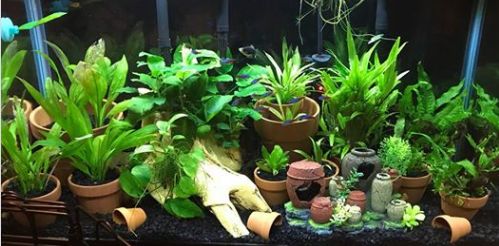
Substrate Where the Fertilizers are Buried in the Substrate
We highly recommend adding phosphorus and iron into the substrate in the form of root tabs. More about these tabs can be found at this link:
15.5. Plant Fertilizers for the Aquarium
If one uses tabs there is an “optimum” way to do this, with the caveat that Mother Nature can do this very successfully with just about anything.
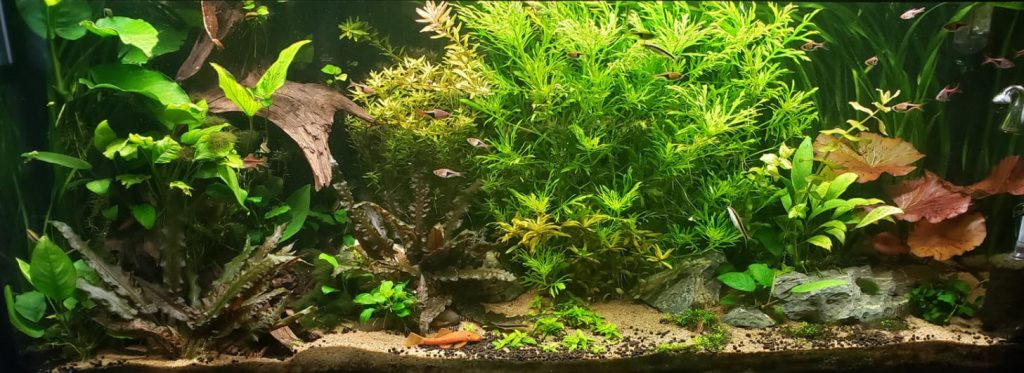
“Soil Under Sand” Substrates for Planted Aquariums
Aquarium Co-op’s forum (great source of data!) gave a very good “advantage/disadvantage” for dirted tanks with sand caps:
Advantages
- Great plant growth
- Very cheap
- Takes years to run out nutrients in the ground
- Good option if you won’t ever change the design (e.g., no moving around plants)
Disadvantages
- Not as easy or beginner-friendly as inert substrate
- Makes a huge cloudy mess if you move plants or have bottom dwellers that dig
- Can lead to toxic ammonia spikes or unsightly algae growth
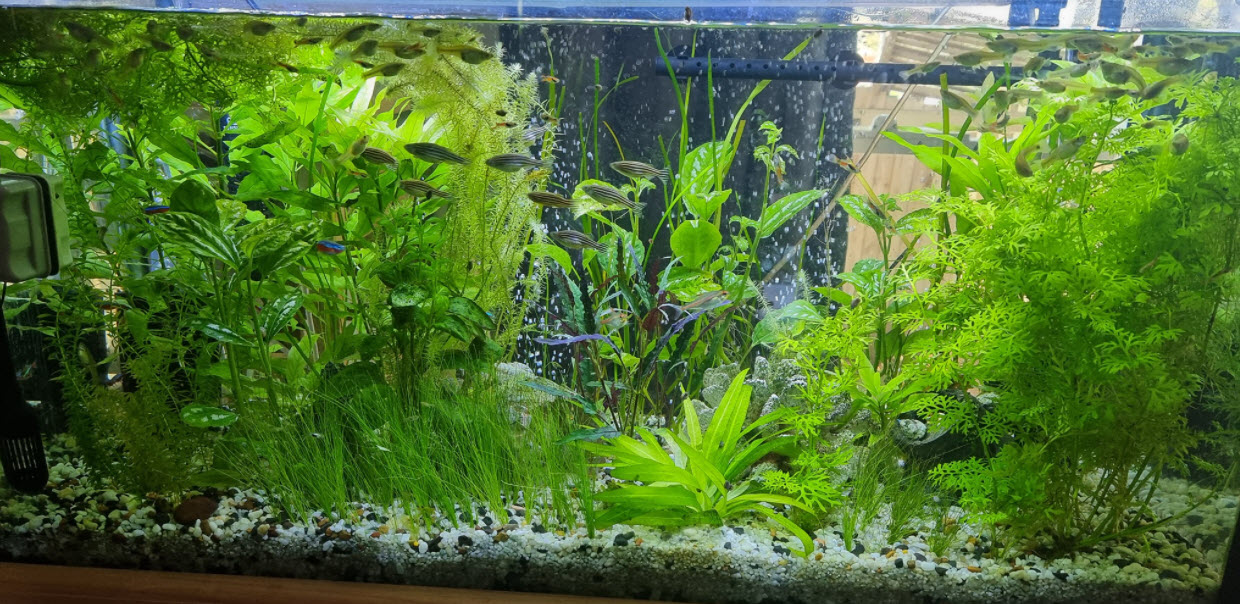
There are a whole series of ways to use “soil” based substrates where the soil layer is buried under a layer of sand or gravel:
- Diana Walstad uses 100% Miracle Gro Organic Choice Potting Mix (MGOC). Unlike many other “potting soils”, MGOC has a clear list of ingredients and a nutritional analysis on the bag:
- 50-55% composted bark
- Sphagnum peat moss
- Pasteurized poultry litter
- “organic wetting agent” (whatever that is)
- Analysis 0.10-0.05-0.05
- One inch layer of wood pellets (see the “Hybrid Method” link below) mixed in with some phosphate fertilizer
- Father Fish makes a very nutrient rich mix of various amendments under two to three inches of sand.
These are all very good soils for the first one inch in any planted aquarium, low tech or high tech.
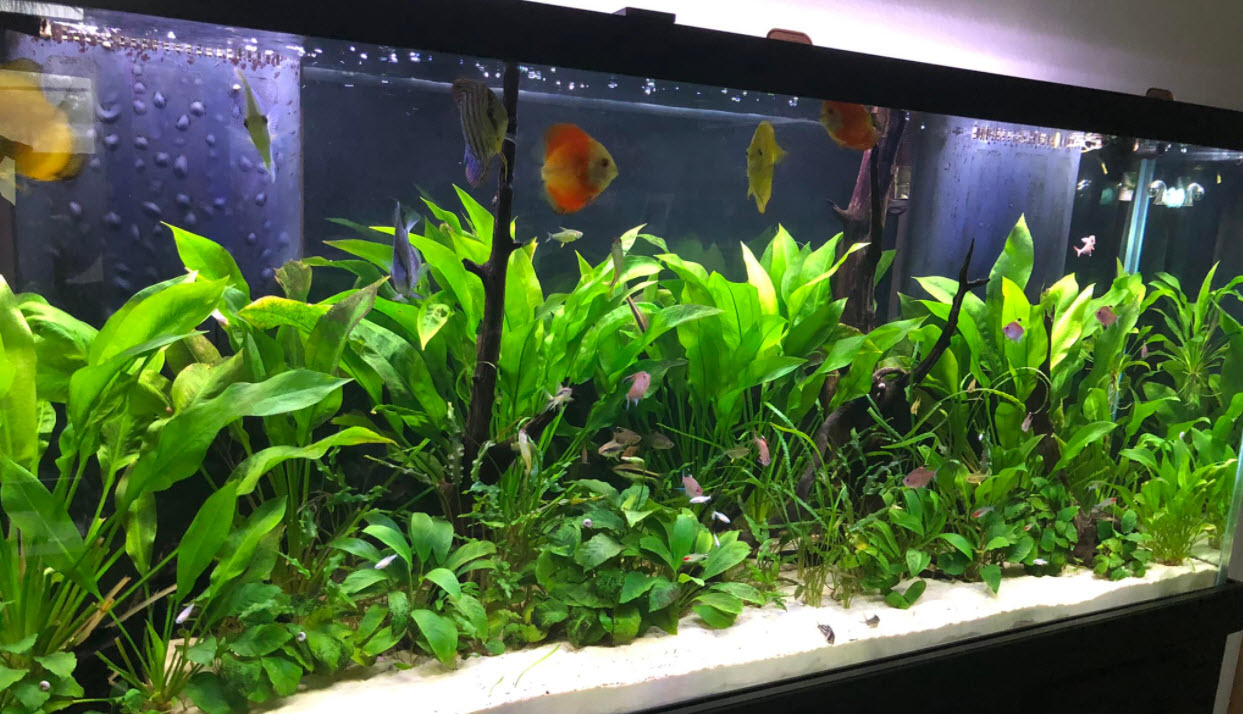
Some commercial bagged garden soils have some problems:
- They sometimes contain little white particles of something called “perlite”. Perlite floats. So if one uses as commercial soil with perlite in it one will get annoying little white balls floating around one’s tank for years.
- Most commercial soils are sterilized. So to use them one has to mix in several handfuls of something like “Black Kow” composted cow manure (pond mud is even better!) to put a whole host of beneficial little organisms back into the soil. These organisms are essential to a planted tank.
- Many commercial soils are fortified with fertilizer. If the soil has an analysis like 1-1-1 it isn’t optimum. The nitrogen is too high and it will be in a very soluble form.
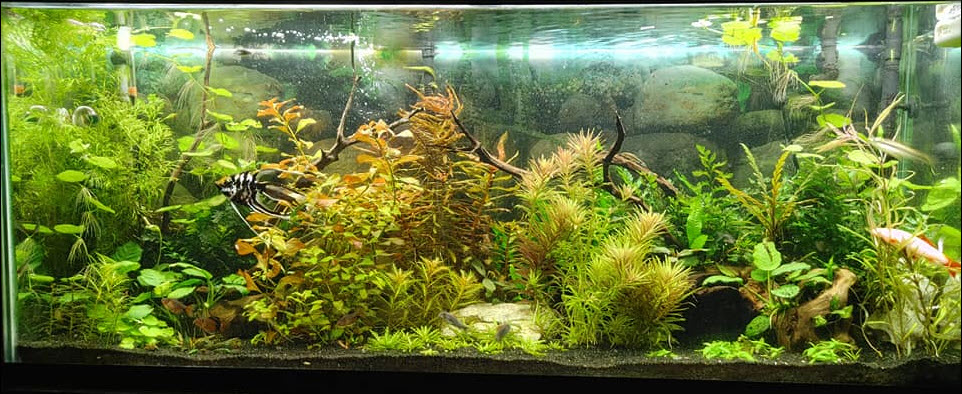
The reason for the organic matter is that one wants there to be some material being oxidized in the substrate. This consumes some limited oxygen and creates what is known as a reducing acid environment. This environment will have a low “redox” or “ORP”. This in turn is the best environment to preserve the availability of iron and phosphorus. But if one uses something like an organic soil with more than 0.10% nitrogen the organics will decompose too much and produce too low of an oxygen condition. Plant roots like some reduction but not too much reduction in oxygen at their roots.
And the Walstad and Hybrid methods use cellulose from wood to create carbon dioxide which slowly fertilizes the water above. These two methods basically create a slow low level CO2 injection system. These methods work very well.
After adding this first layer, add a second dry layer of one inch of sand or sand and gravel without organic matter. Make sure to match the color of the second top layer to the underlying layer. In the course of planting and maintaining plants some of the underlying layer is going to inevitably come to the surface. If the two layers are different colors the look can be really bad.
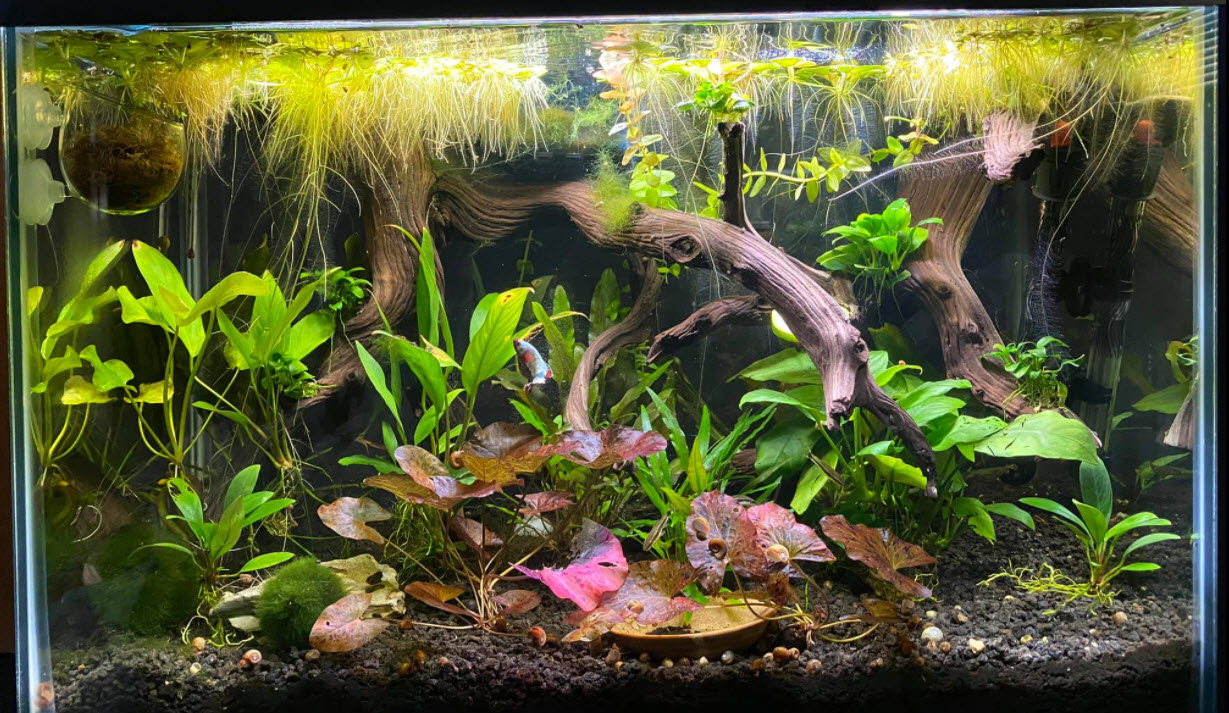
And it is important to let this soil “mature” under water for at least six weeks before adding plants. If the soil has not “matured” for at least six weeks it can actually kill plants. The problem has to do with the amount of easily decomposed organic material in the soil. If the soil has a lot of easily decomposed organic matter in it the soil can “sour” and go to levels of oxygen less than 1 ppm. This low level of oxygen can kill plant roots. After roughly six weeks the easily decomposed stuff will be pretty much gone and the oxygen levels should be above 1 ppm.
Various research papers found by Diana Walstad in her excellent book (“The Ecology of a Planted Aquarium”) also noted that the pH of virtually all soils which are under water tend to stabilize at a pH of 6.0 to 7.0 after six weeks of maturation. This range of pH is what plants like.
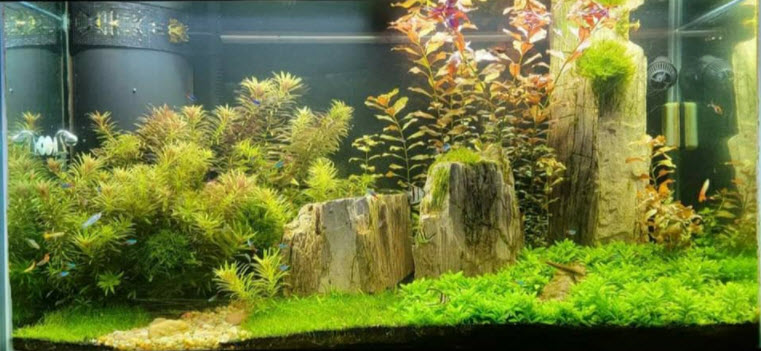
Now one can put the plants into the aquarium while the soil is “maturing”. Just do not put the plants into the soil. Just leave them in the aquarium above the soil. Note that most aquarium plants die back some when initially planted and take two to six months to take off. If one does not put plants into the aquarium initially for the maturation period, leave the lights off and cover the tank with black plastic while the soil matures. This keeps algae from gaining a foothold.
Again, this has just produced the best results for me. There are about one million variations on this theme which can all give good results.
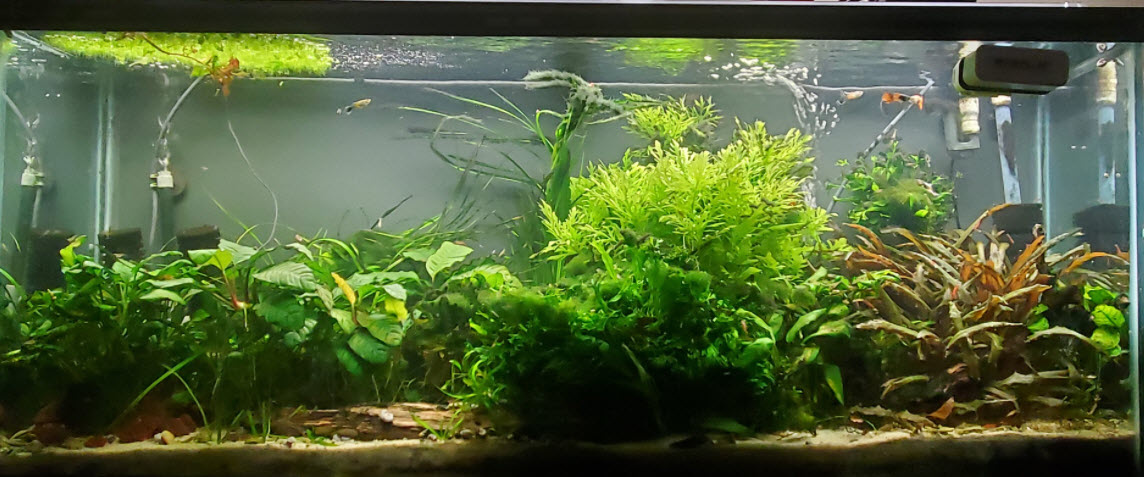
Substrates if One Puts the Iron and Phosphate into the Water Column
This topic is quite involved. Only read on if you are interested in getting quite confused. The whole matter can be simplified by saying simply:
.
“Put your Iron and Phosphorus into the Soil, NOT into the Water Column”
.
A plant enthusiast who wants to grow lush plants with fertilizer in the water column or/and an open substrate needs to understand the chemistry of fertilizers and aquarium water. In general, if one has high pH, high KH water an aquarist should NOT put iron and phosphate into the water column. Iron and phosphorus in this situation are best added to a fine substrate (“Soil Model of Iron Phosphate Solubility”, Blanchar et. al. 1991, “Influence of Sorbed Phosphate on the Stability of Ferric Hydrous Oxide Under Controlled pH and Eh Conditions”, Willet et. al. 1983).
If one has low pH and low KH water, one CAN add iron and phosphate to the water column and use any size substrate. But we still recommend a small particle substrate and additions of iron and phosphorus only to the substrate, not the water column. This makes the iron and phosphorus unavailable to algae.
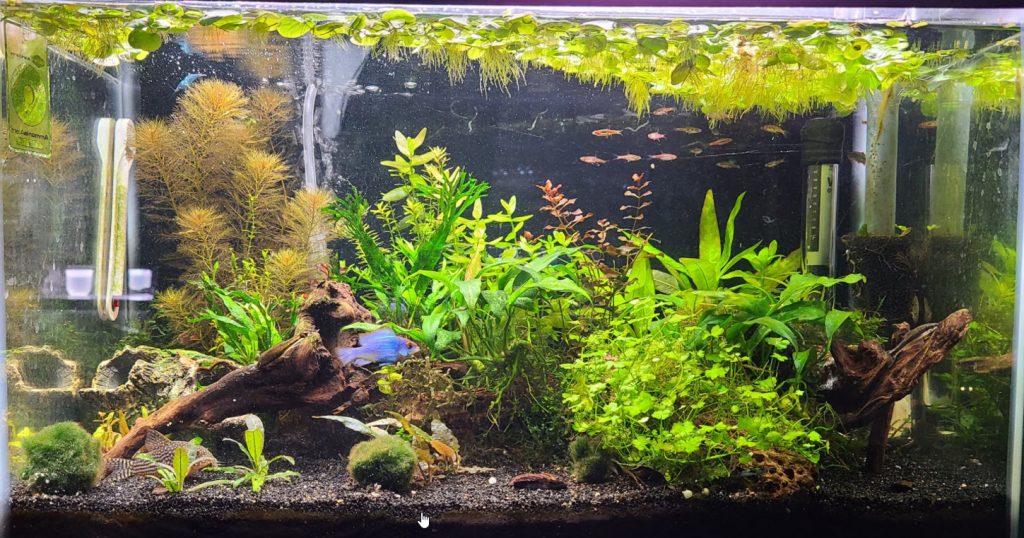
Substrates and Iron Fertilizers
This topic is quite involved. Only read on if you are interested in getting quite confused.
The question of where to make iron additions depends to a certain degree on the water chemistry. There are two forms of iron. One is called “ferrous” and plants can utilize it. The other is called “ferric” and plants cannot utilize this. Plants only need extraordinarily small amounts of ferrous iron! But plants need ferrous iron on a constant basis. And ferrous iron is notoriously simple to make unavailable to plants, especially with alkaline (above 7.5 pH) water.
There are three possible scenarios for iron:
- High pH >8.0
- pH Between 7.5 and 8.0
- Low pH <7.5
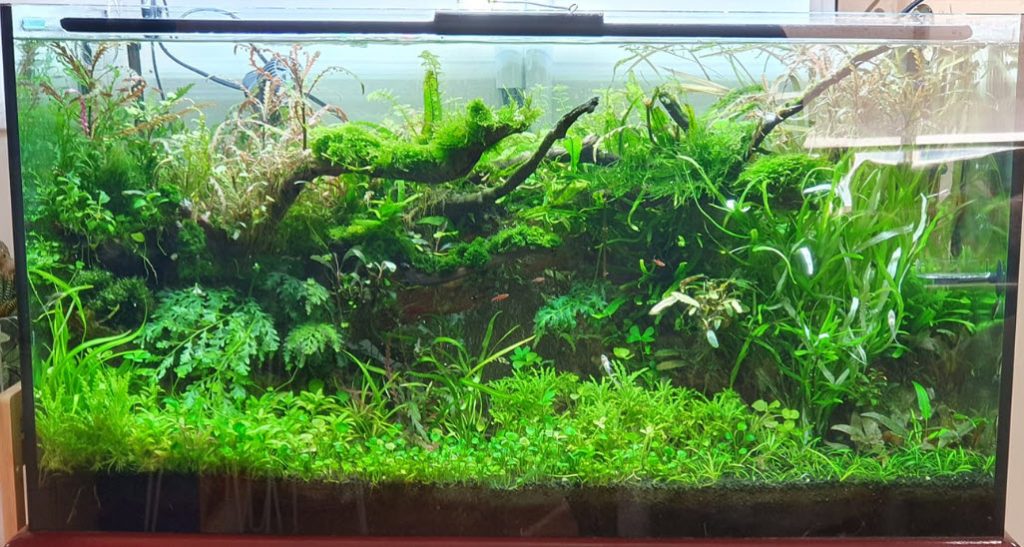
Substrates and Iron at High pH >8.0
If ferrous iron is added directly to high pH water, it will be unavailable to plants in hours. So, if the aquarist has water with a pH over 8.0 one needs a small particle substrate where the iron is added to the substrate in slow-release form. A small particle substrate (less than 1.8th inch or 5 mm) will accumulate organics and prevent rapid oxygen permeation. Organics acidify the water and lessen the oxygen. So, the iron placed in an organic enriched substrate will be available to the plants in its ferrous form, even if the water above is alkaline.
If one adds iron to water over 8.0 pH that has phosphate in it the iron will be very rapidly tied up in very insoluble iron phosphates. With a pH over 8.0 it becomes doubly important to add both the iron and the phosphate to the plant roots in a fine substrate.
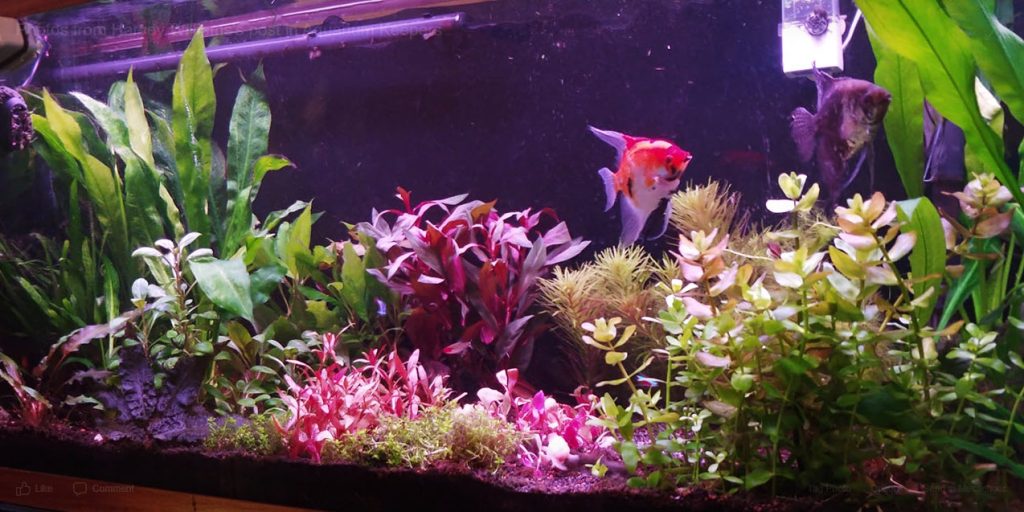
Substrates and Iron at a pH Between 7.5 and 8.0
The availability of iron at 7.5 to 8.0 pH will be highly variable depending on a lot of other factors. To be on the safe side I recommend small particle substrates with iron and phosphate additions to only the substrate.
Substrates and Iron at Low pH <7.5
Iron at in water with a pH less than 7.5 will become ferric over the span of two days or more. If the aquarist has water with a pH under 7.5 the aquarist can successfully add tiny amounts of iron to the water column every two days or so.
If the iron is added to the water column the size of the substrate becomes unimportant. Note that iron added to the water column obviously will be available to algae as well as plants. Obviously, rooted plants can absorb iron placed in the fine substrate where algae cannot get to it. In our section on plant fertilizers we show how to make tabs which very slowly release very small amounts of ferrous iron into the substrate.
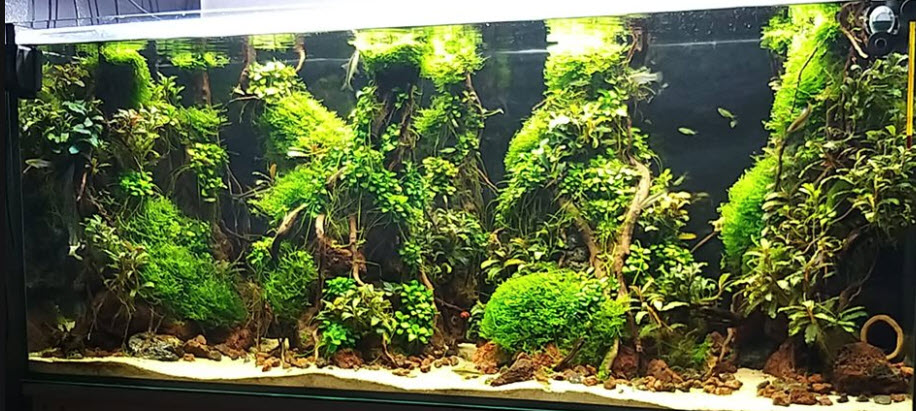
Substrates with the Topic of Iron and Phosphate Combined
If iron is added to phosphate rich waters under a pH of about 6.5, the iron phosphates that form are somewhat more soluble, and plants can take them out of the water column. But between 6.5 and 8.0 pH it becomes somewhat of a gamble. Sometimes one will get good results and sometimes one will not get good results.
Since the “natural pH” of most aquariums is 6.5 to 8.0 pH this presents a problem. Phosphate does not rapidly become insoluble under all aquarium conditions. If one adds phosphate to the water column in most aquariums, even high pH waters, the phosphate sticks around till plants use it up. But when the iron is added to the water column the iron will be tied up by the phosphate and become unavailable to the plants in 5 to 20 hours at 6.5 to 8.0 pH. So daily or every other day iron additions become necessary.
Above a pH of 8.0 the addition of iron to any water with phosphate in it will result in very rapid immobilization of the iron. In water with a natural pH above 8.0 the addition of iron to phosphate filled water is useless.
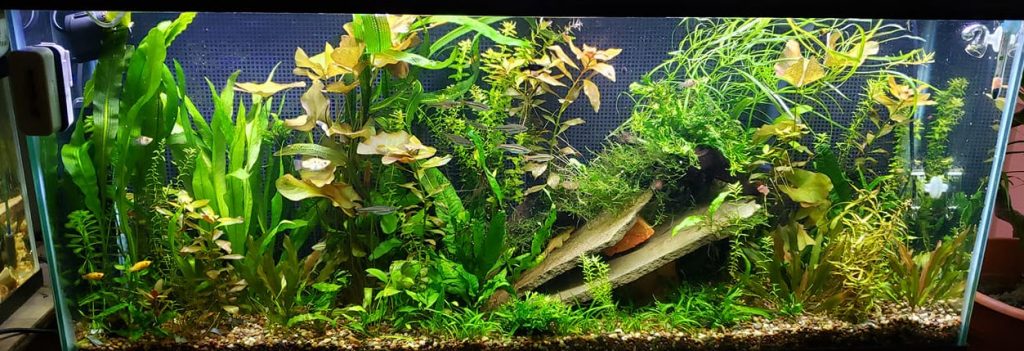
Carbon Dioxide Additions
High pH high KH water will require fine substrate and iron put into the substrate pretty much regardless of CO2 injection levels.
The best planted aquariums are those which have carbon dioxide gas added at a level of 30 ppm. But this introduces another variable. Carbon dioxide is acidic. So, a carbon dioxide added tank can go down to say 6.0 pH and then cycle up to 8.5 pH quite easily IF the KH of the water is low. If the KH (carbonate hardness) is high generally the pH will be high.
And high KH water is “buffered”. This buffered water will NOT drop much in pH even if the water is injected with 30 ppm carbon dioxide gas.
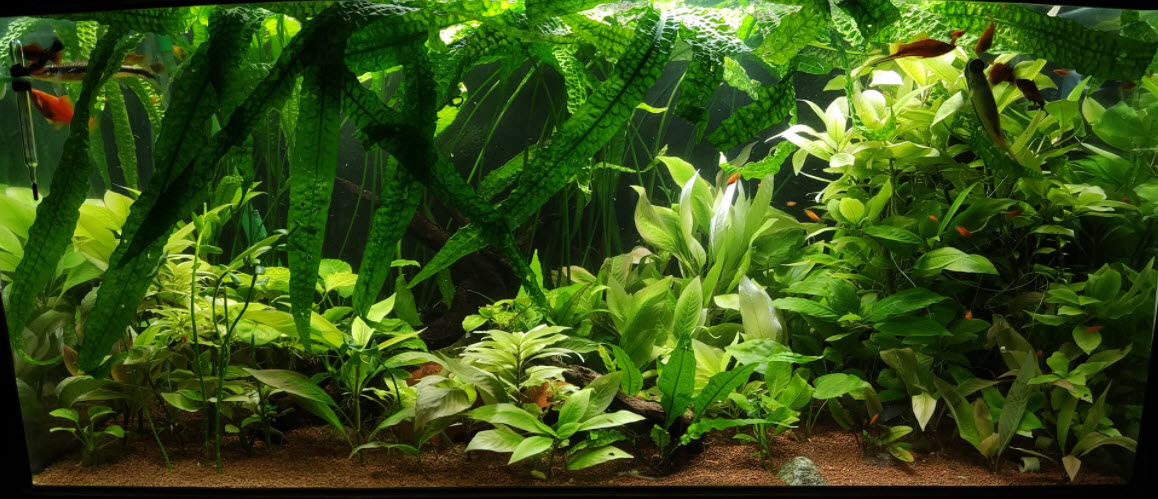
But carbon dioxide injected waters often measure as very low pH and low KH waters, especially in the afternoon and evening. These measurements can give an incorrect picture. The challenge here is that the formation of insoluble iron compounds at high pH is irreversible. If one adds iron in the late afternoon to a carbon dioxide injected tank and the pH goes up to 8.5 at 3:00 AM in the morning, the iron will only be around for a few hours before becoming insoluble.
It becomes important to measure the “natural pH” of the water. Leave the water being used in a tank or container for a few days with no CO2 injection. Measure the pH and KH. If the “natural pH” is over 8.0 and the KH is over 5, one will probably not do too well with adding iron and phosphorus to the water column, even with CO2 injection.
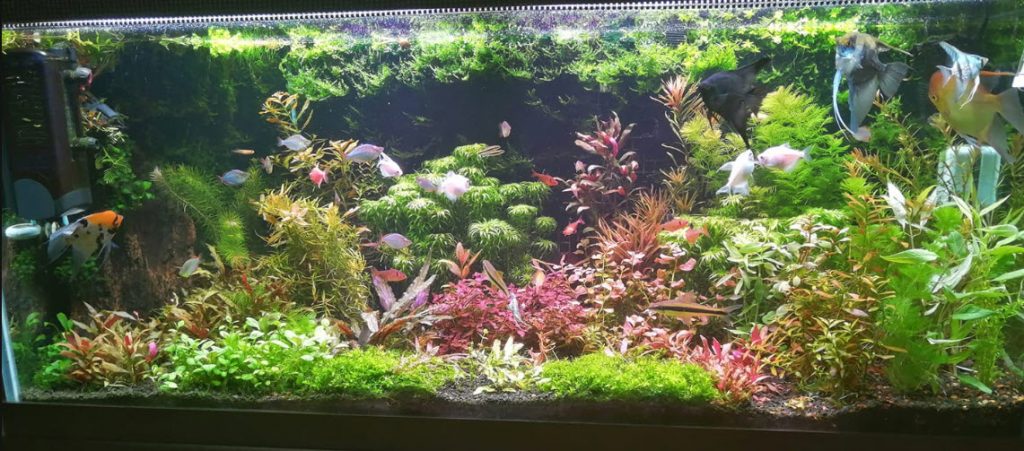
Planted Aquariums in Depth
The following sections will tell you how to make a planted aquarium:
15. Planted Aquariums
15.1. Planted Aquariums in Depth
15.2. Fish for Planted Tank
15.3. Fish Limitations
15.4. Types of Planted Aquariums
15.5. Fertilizing
15.6. Carbon Dioxide
15.8. Walstad Aquarium
15.9. High-Tech Planted Aquarium
15.10. Hybrid Planted Aquariums
15.11. Many Fish Many Plants
15.12. The Hau Aquarium
.
Return to Home Page and Main Menu
.
Aquarium Science Website
The chapters shown below or on the right side in maroon lead to close to 400 articles on all aspects of keeping a freshwater aquarium. These articles have NO links to profit making sites and are thus unbiased in their recommendations, unlike all the for-profit sites you will find with Google. Bookmark and browse!
.

Jaume says
I’d like to add to my previous message. My npk calculations were off, but I used that soil anyway. I followed the ~1 inch soil and ~1 inch gravel cap, planted as much as I could (bacopa, sagittaria, anubia, crypto). For a while the soil leached a lot into the water, murking it, which I tried to solve with water changes. After a while I noticed some spots where gravel was thinner, and where some sort of veil or semi-floating translucid film was forming. I added more gravel to cover these spots, which resulted in much clearer water, so I stopped changing it. After a while snails started to appear, many of them! Also tiny white worms which I assume are detritus worms. I added water lentils and, while some black small clumps of algae started to appear, they seem to be under control now. The aquarium has no artificial light, but it is in front of a glass door that leads to a 4th floor terrace with a lot of indirect light most of the day. Bacopas are thriving and very mobile ( I rotated the aquarium and they reoriented themselves quickly), the rest seem to be adapting well. I am very happy with how this one is going, I may add some small hardy fish soon. Thanks for the tips.
Jaume says
Thank you Dave, I’ve read more closely Walstad’s substrate chapter, and she recommends Nitrogen being below 0.10% ideally. Then, found out this “Universal ecological peat-free substrate” that has “Vegetable compost, Wood fiber, Composted pine bark, Worm humus” and has value of NPK 2-1,5-1,2 2g/L. Which as far as I understand means that there are 2 gr per liter of which 2% is Nitrogen, which would result in about 0.17% nitrogren total (unless I misunderstood or miscalculated), a value very much around what Walstad reccomends. So I will try this one, and see how it goes.
Thanks again.
Dave says
In reply to Jaume …… Any of the first three “soils” are largely wood fibers and will work. The third “soil” has perlite which is a small problem. The “aquarium soil” is a partially fused clay which won’t work in any Walstad.
Jaume says
Hello,
Thank you again for your articles.
After a first aquarium that went ok for the plants, not so much for the fish, I am trying a tiny (+-12l) planted aquarium, Walstad-like. Bought the book, etc. I went to find “organic and unfertilized” potting soil, and it has been frankly impossible, or I haven’t understood the details. This are three examples of commonly found substrate around here (near Barcelona, Catalonia):
1 “COMPO BIO Substrato Universal sin turba” (sin turba = without peat) that claims to have “A particularly high proportion of humus and a rich mixture of natural fertilizers provide plants with nutrients for 2 to 5 weeks.”. The bag had additional info, but I cannot find it on the internet atm.
2 A similar substrate from the same brand, specifically for “orchard and fruit trees” claims to contain “28% Composted pine bark, 27% vegetable compost, 25% fiber wood, 20% coconut fiber, organic fertilizer of animal origin NPK13.5+8.5+2 (1.2 gr/l guano fertilizer) and organic nitrogen fertilizer of animal origin N14 (2.2 gr/l horn flour fertilizer”, which is fertilized and seems to go against some of the details you provide, like high N.
3 A third and last example of “universal substrate without peat” this time with “ecological inputs” from “Bio Flower” brand, claims “Vegetable compost, composted pine bark, coconut fiber, fiber wood, sheep manure, perlite and ecological inputs.” with a PH of 7m2, and “Organic Matter/Dry Matter = 50%”.
As these seemingly did not match the description of “unfertilized organic soil”, confused and defeated I ended up buying “H.E.L.P. advanced soil Plants” expensive aquarium soil. They do not give info on the contents of this soil, of course. And one thing that bothers me is that now I see that it is not supposed to be “capped” gravel (I have 2-3mm gravel) or sand, as Walstad suggests.
Now, I am even more confused to the point of considering going to get some soil from the nearby forest and call it a day.
Could you help me make sense of this information, in the context of a Walstad approach, please?
Thank you very much,
Sagi says
Fluval Stratum been mentioned in both Calcined and baked substrate types.
Sagi says
Safe-t-sorb considered inert substrate, right?
Sagi says
No Kitty Litter for sale online..
Sagi says
What in your opinion is maximum reasonable price one should spend on aqua soil substrate?
Sagi says
Let’s clarify something: Baked Substrates (sometimes called “active” substrates), are not made of Calcined clay?
Sagi says
Hi,.. adding a lot of nitrogenous organic matter,.. such as?
Confused fish keeper says
Thank you for such useful information. Can’t help leaving questions/ comments all over this site. Won’t root tabs end up dissolved and in the water column? And won’t the water flow into the substrate, so that iron put into the water column will reach plant roots? And won’t plant roots do what they do best and grab the nutrients where they can? Second, just because I haven’t seen where to ask about Father Fish method of adding decaying plant matter from a pond and the possibility of introducing disease or harmful micro flora/fauna? For salt water aquariums, I’ve seen information about decontaminating corals in Iodine?
Dave says
In reply to Michael …. There are hundreds of options. It all depends on whether you want your tank to have mainly fish OR mainly plants. If you want mainly plants I might try a Walstad tank. Note I’m recommending one steer clear of the Father Fish method. Some of my readers have had them turn into cesspools.
Michael says
Evening Dave,
I’ve been getting so much out of these articles and am curious about one thing.
I started a low tech tank a few months ago with some black diamond substrate and decided it may be beneficial to some how add nutrients to the soil and/or possible cellulose in some form.
Is there a viable way to do this or should I just keep the substrate as is? Maybe I’m over-complicating things.
Thank you!
Phil says
Dave –
RE: “Safe-t-sorb from Tractor Supply is incredibly cheap and very effective as a substrate.”
I’m currently DIY’ing a UGF for a new 75 gal tank and chose Safe-T-sorb for substrate. Regular aquarium gravel is ridiculously priced especially in quantity needed for larger tanks.
Safe-T-sorb contains considerable fine material and dust. In an effort to keep most of the fine material from clogging the UGF plate holes I’m screening out the Safe-T-sorb fine material before rinsing and adding the larger materiel to the tank.
In addition I thought I would use weed block fabric over the UGF plate. But apparently not all weed block fabric can be used. I purchased some from Amazon and tested it over kitchen sink. Water will not pass thru the weed block fabric I chose – maybe other weed fabric will but I’m not buying any more to find out.
Plan “B” now is to use fiberglass window screening over the UGF plate.
Anonymous says
That’s very clear, thank you. I suppose another slight area of disagreement is that you’re not keen on brownish water (DOC heavy), while Walsatd is. 😉
I’ll keep the Juwel filter, then, and think about moving the outflow to the bottom of the (tall) tank…
Thanks again!
P.
Dave says
In reply to Patrick …. This is one of those area where I disagree with Walstad. Yes, plants absorb ammonia in preference to nitrate. But they still absorb nitrate just fine. Every aquarium plant fertilizer out there that you can buy is a nitrate based formula. So I add big filters with good media (foam, pot scrubbers of K1) to even a Walstad aquarium. I do outlet the flow deep in the aquarium to prevent CO2 removal by the outlet flow. Yes the beneficial bacteria remove ammonia, but they convert it to nitrate, which plants can utilize just fine. And the filter does so much more beneficially than just ammonia oxidation (disease pathogen removal, DOC removal).
Patrick Eason says
Thanks, Dave!
I am reading Walstad again, and one of her main points is that classic bio filters compete with plants for ammonia, so if you want good plants (and all the benefits they bring), don’t over do it with the bio filtration. So – do you think the tanks’s own big modern biofilter will be overkill (for a dirtied tank). Maybe I should try replacing it with something smaller/simpler?